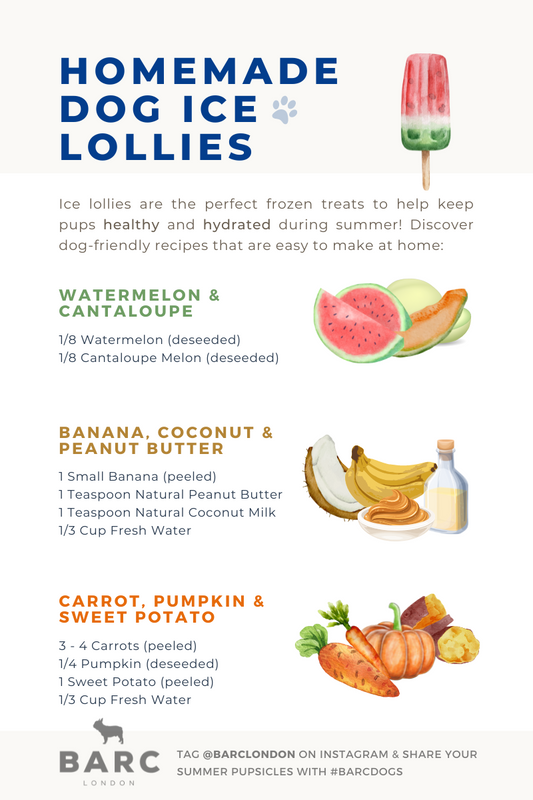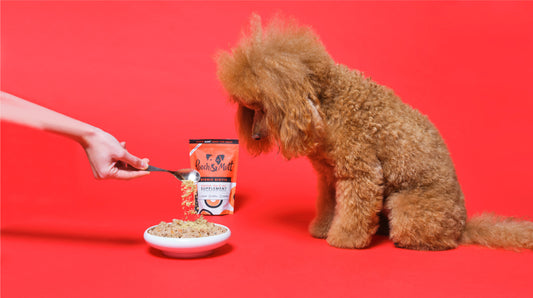Share this Image On Your Site
Please include attribution to https://www.barclondon.com/ with this graphic.
Three of the most important aspects of dog ownership include socialisation, training and providing them with the best nutrition possible!
A healthy and balanced diet has a positive impact on a dog's current and future health, and also helps to reduce the chances of behavioural issues from occurring.
In fact, a dog’s diet can play a larger role in their overall quality of life than many dog owners realise.
Did you know that a large percentage of serotonin is produced in the gut, rather than the brain? This means that a healthy microbiome can have a direct impact on how happy and relaxed a dog is.
But if you’ve never owned a dog before, getting to understand the ins and outs of feeding can be tricky.
We’ve put together a short guide, complete with a dog’s nutrition chart to get you going.
While this is a great starting point for finding out more about a dog’s diet, please remember that you should always seek specific nutrition advice from your dog's vet.
Dog Nutrition Guide:
- What are the nutritional requirements for a dog?
- Important nutrients:
- Dog feeding guide:
- Top tips for dog's nutrition:

What are the nutritional requirements for a dog?
It’s important that your dog gets a balanced diet which should include protein, fats, carbohydrates, vitamins and minerals - all washed down with a fresh supply of water.
Dogs are omnivores, which means that they are able to digest both animal and plant matter, but vets recommend that the highest percentage of your dog’s diet should be meat.
What percentage of a dog's diet should be meat?
Meat makes up a big part of a dog’s diet, and generally speaking, should account for at least 33% or two thirds of their daily feed.
Important nutrients:
More and more research into dog nutrition has been carried out over the years, and it’s a minefield to say the least. With so many options - from raw to fresh feeding, wet food to kibble - where do you start!?
The main thing to consider is ensuring your dog gets a complete and balanced diet that includes the following essential nutrients:
🥩 Protein
Dietary protein is one of the most important factors in ensuring healthy growth through a dog’s life cycle.
Growing puppies require around twice the amount of protein as adult dogs, as it also provides a great energy source for playful pups that haven’t yet started to calm down and settle into adolescence.
Great sources of protein for dogs include meat, fish and eggs. This is because dogs tend to find meat and fish the easiest to digest naturally.
💡 Top Tip: Lots of low cost dog food uses protein substitutes to save costs. These protein substitutes that don’t come from animal sources can be harder for dogs to break down and digest, increasing the likelihood of dietary intolerance occurring.
🐟 Fat / Oil
Healthy fats are key in dog nutrition, but too much of the wrong fats can lead to health problems.
The right fats can help to maintain healthy skin and a shiny dog coat, as well as controlling inflammation and aiding brain development.
Dogs aren’t able to generate certain essential fatty acids like omega 3 and 6 oils, so the only way they can get them is through certain foods and supplements.
Great sources of healthy fats include low-mercury fish and fish oil, olive oil, flaxseed oil, hemp seed oil, avocado (flesh, no skin or stone), borage and rosemary oil.
🥦 Carbohydrates
Healthy carbs help to supply important vitamins, minerals and antioxidants for dogs.
These carbohydrates are recommended to be high in fibre, which is being increasingly recognised as beneficial for a dog’s health.
Dog safe fruit and vegetables are an ideal source of carbohydrate, as are legumes.
While dogs don’t need grains in their diet, certain grains have been found to provide a good source of fibre, helping to absorb excess water in the colon, and function as a prebiotic for good intestinal bacteria.
💊 Vitamins
Just as with humans, vitamins play an essential role in a dog’s health.
Because a number of food production methods involve food being cooked at high temperatures, certain dog foods do not contain enough of a dog’s daily natural vitamin requirements.
Great sources of vitamins can be found in meat, bone, shellfish and organ meats, as well as vegetables and fruit (in small amounts).
The main vitamins that are important for dogs include Vitamin A, B, C, D, E and K.
💡 Top Tip: While many people believe that senior dogs require a diet that provides additional vitamins and minerals, there is currently no evidence to support supplementing an older dogs diet in this way.
🥕 Minerals
All feeding guides should highlight the importance of minerals in a dog’s diet.
Minerals help with a number of body functions and processes, helping with metabolism, skeletal structure, muscles, bones, teeth development and more!
‘Ash’ is the term used to measure the amount of minerals found in food, so when exploring different dog food options, it’s a good idea to look for choices that have higher ash contents.
It’s particularly important for growing puppies to get sufficient minerals, due to the fact at this life stage their body needs these minerals for healthy development.
💧 Water
Hydration is extremely important for active dogs, so you should make sure your pup has access to clean and fresh water at all times.
Generally speaking, advice recommends that most dogs need to drink one ounce of water for every pound of body weight per day.

Dog feeding guide:
It’s advised to feed your dog between 2 - 3% of their body weight, which can be split into two or three meals a day.
Keep in mind that all dogs are different, and some may require more or less depending on breed, size, age and activity level.
More and more research has been conducted into the health benefits of feeding your dog raw or gently cooked fresh foods, but we appreciate raw feeding isn’t for every dog or for every pet parent.
If you do feed your dog kibble, make sure it is the best and highest quality that you can afford, and take time to think about feeding your dog added fruit and vegetables, a raw egg or even some oily fish as a healthy topper.
Cold pressed and freeze-dried kibble foods are good alternatives to a raw diet, and offer some great health benefits!
Does dog food have enough nutrients?
It really depends. All-purpose dog food might not provide the required nutrients for pregnant dogs or growing puppies, and sometimes cheaper, processed kibble provides little nutritional benefits at all.
For this reason, it’s always a good idea to research the best dog diet formulated specifically for its life stage.
All About Dog Food allows you to input your dog’s details to find out which food is the most or least nutritious for your dog.
You can search for the food your dog is currently on, and find out if there is a better option available within your budget.
💡 Top Tip: Your dog should be being fed food that has a minimum nutritional rating of 75%, but the higher the better.
Tips for dog nutrition:
- Organic fruit, veg and grass-fed meats are ideal for the ultimate in doggy nutrition. Pesticides can also wreak havoc on our dog’s health as well as our own.
- Dogs are what they eat and what their food source eats: For dogs that can’t have grains, it’s important to be aware that a lot of animals are fed on grains. So although your dog may not be directly eating grains, depending on the protein source, they may still be ingesting them in other forms.
- Nutrition impacts physical health and behaviour: What you put into your dog will affect what comes out both physically and behaviourally. Like kids, the more junk food they consume, the more hyperactive they are and the higher the risk of developing health issues later down the line.
- Variety is key. Your dog’s diet can affect their stress, anxiety and confidence level. Like us humans, dogs can get bored of eating the same food day in, day out. Providing a varied diet will create a happier and healthier microbiome and improved gut flora.
- Treats are great for training and aiding your dog’s learning. However, dog treats can also be highly processed with junk food and empty calories. Try to find natural treats and chews that your dog loves. Some good options include:
- Treats - chicken, carrot, apple, cheese, cucumber, or freeze-dried treats such as liver (avoid for Dalmations) or fish
- Chews - yak chews, antlers, bull horns, pizzle sticks, ears and for those that like to chew wood, coffee wood and anko roots are great! Just make sure to supervise your dog whenever they have a chew.

❗Important: As mentioned previously, while our dog nutrition chart provides a general guide for feeding, it's crucial to contact your vet for specific dietary advice.



